Minimal Audio, the maker of some of the more unique effects in recent years, is now stepping into the synth space with Current. And they’ve got a real mothership of a synth, merging tons of synthesis and effects ideas into one instrument. Here’s a breakdown. Update: shortly after publishing, Minimal Audio reversed the subscription model for a combination of conventional purchase and rent-to-own option. More details shortly.
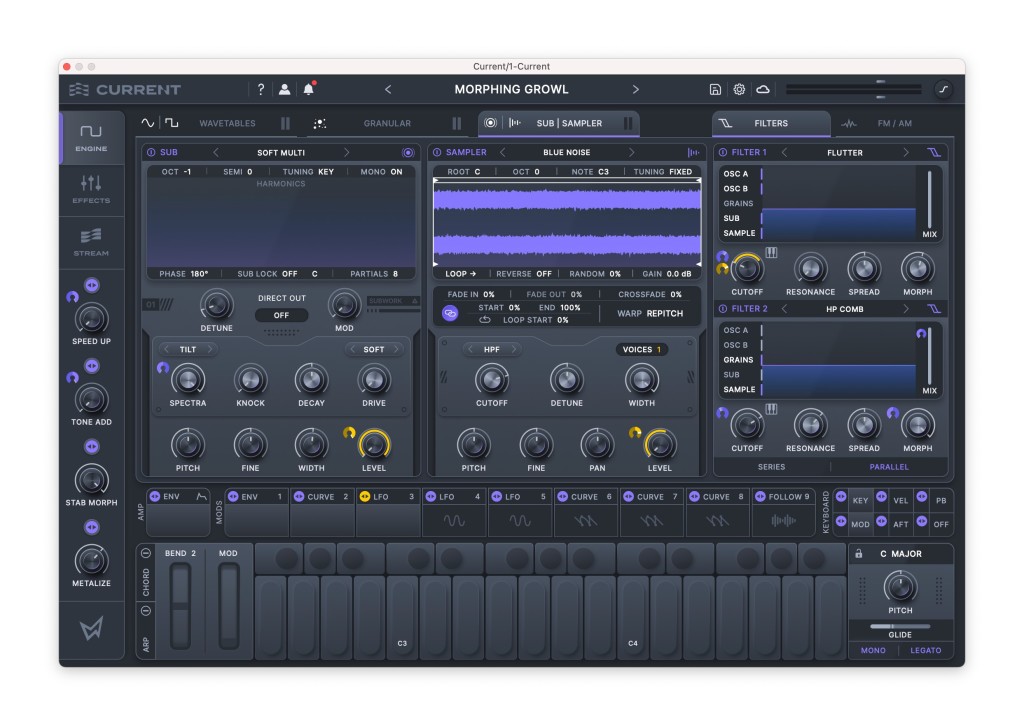
I expect we should address the subscription side first. Minimal has mainly been doing standalone effects – a la carte purchases. Minimal also tells CDM that they plan to continue to develop and release new standalone products that are pay-to-own. Don’t overlook those, either – see my reviews of Cluster Delay and the Rift distortion, plus there’s a terrific multiband compressor/shaper called Fuse. (In fact, if you can’t abide subscriptions and no one will change your mind, don’t hate-read the rest of this, just trust me and check Fuse! I’ll carry on here; you go for it and enjoy!)
Before Current, Minimal recently released its first subscription offering, Stream, which launched a boutique credit-based sample collection. For their first synth, they’re also opting for the subscription model. (See below for some more details about how this works.)
So, my guess is for subscriptions in music, companies can pull it off with customers if they release the Mandalorian / Andor level of offerings. I’ve had access to a prerelease build of Current, and it might qualify. It’s a multi-engine, multi-effect megasynth. But it retains that friendly, consistent Minimal Audio UI style.
The subscription hook here is that The Stream is now expanded from sample library to preset and wavetable feed. There’s plenty to keep you busy at launch, and presumably, the subscription will prove itself if they’re able to keep adding.
But let’s deal with what’s here at launch in the actual Current synth.
Engine
Granular sampling, spectral wavetables, an additive sub-oscillator, time-stretching sampler, and morphing filters are all packed in here. To me, it’s really the sampling capabilities that set this apart – especially since we have a lot of wavetable/virtual analog hybrid synths with tons of modulation already (Serum, Pigments, Massive X, Hive, etc.).
Even the Sampler is powerful but simple, with free and ratio-based time settings, conventional repitch or time/pitch-independent flex mode, and drum, bass, and clean settings for flex-mode sample material. The Granular engine is the real star here, with controls for adjusting layering and spray (see screenshot).
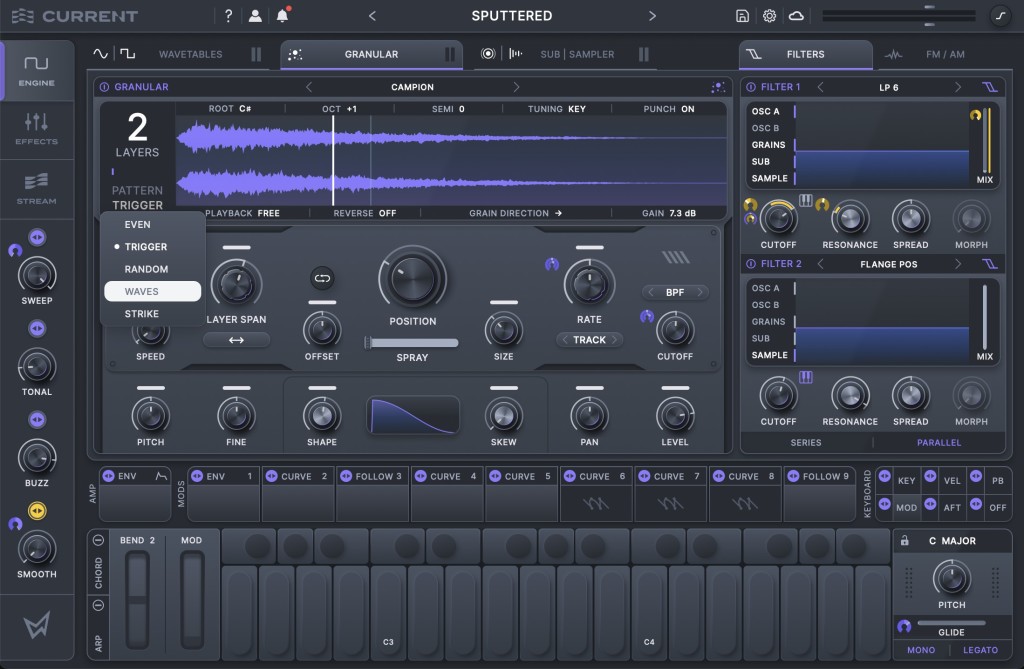
Wavetables are the other side of this, and the edge Current has is a nicely curated library of wavetables to choose from – there’s some personality, which we’ve gotten used to from some of Minimal’s standalone effects.
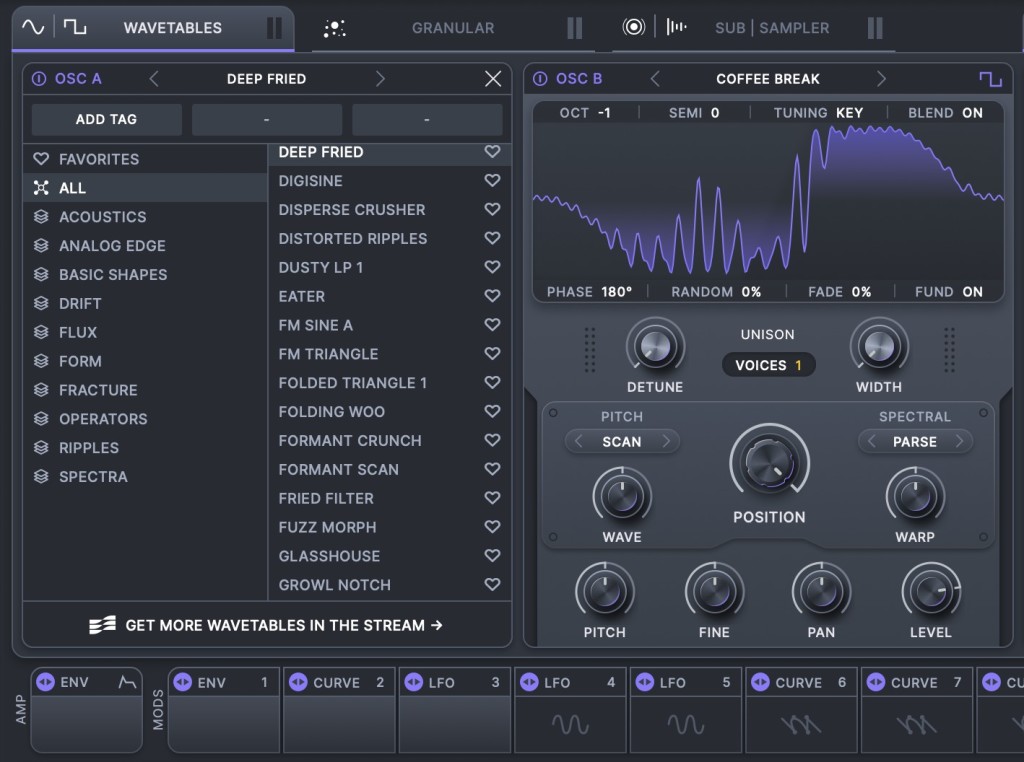
And then, of course, you can give stuff some real bass oomph with that sub-oscillator. Another synth would have just knocked this off quickly with a few settings; Current will demand you to have a subwoofer or monitors with some bass extension, as there are a load of options here.
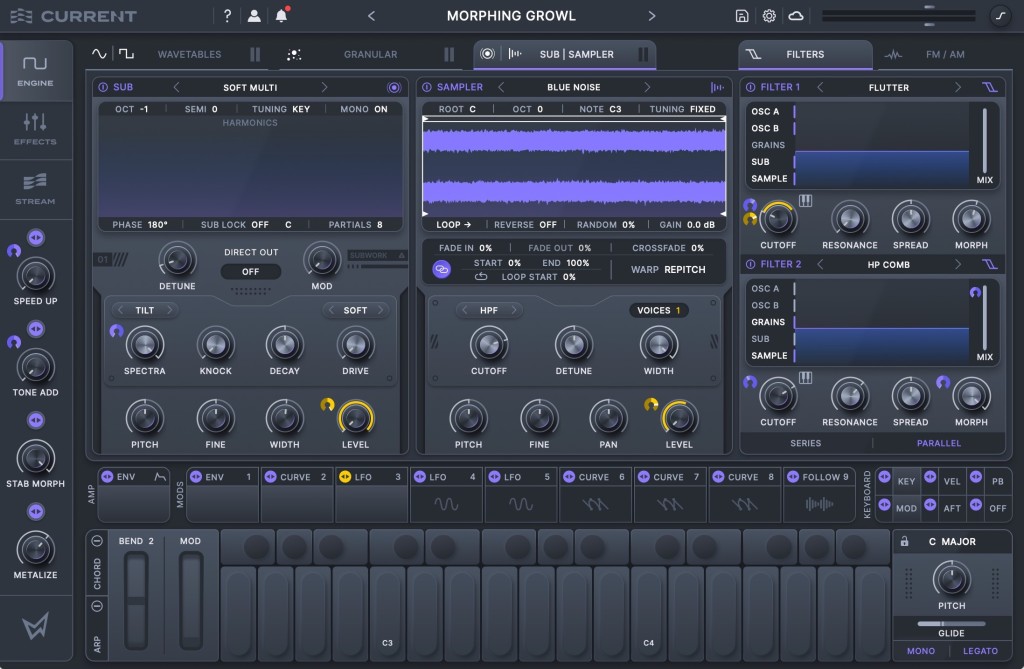
To that, you get a ton of filters, which you can use in serial or parallel – then something else we’ve seen in other Minimal products. And there’s a dedicated, friendly frequency modulation/amplitude section. This might not be as front and center, but you can FM/AM pretty much anything here – and it’s convenient somehow just having these pre-routed for you, without necessarily digging into a matrix. (See also Rhizomatic’s Plasmonic, which does a great job of making these sorts of timbral controls accessible.)

Effects
Nice as that is, the other value-add here is the effects suite. It’s going to be a little redundant if you’ve already invested in Minimal’s audio effects, but if you haven’t, you get a load of goodies here:
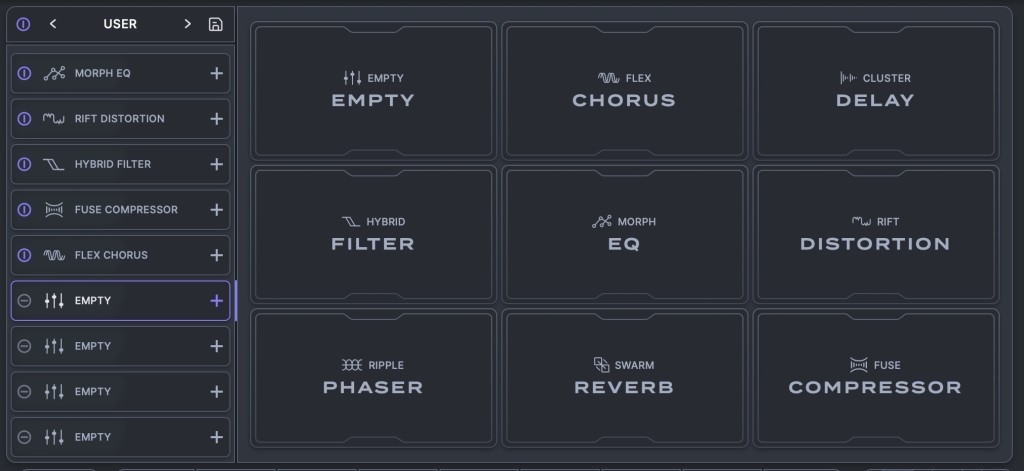
- Flex chorus
- Cluster delay
- Rift distortion
- Hybrid filter
- Morph EQ
- Ripple phaser
- Swarm reverb
- Fuse compressor
And you can load a lot of them at once – up to nine, with the ability to rearrange and save presets. They’re clear that these are V1 effects, as in more are coming.
There is not any way to route audio into Current, and there’s no way to use the effects on their own – like a separate audio effects version of the plug-in (as some dual synth/effect plug-ins offer). That to me seems a big omission; with it, I think the subscription would become a no-brainer, so I hope they offer it down the road.
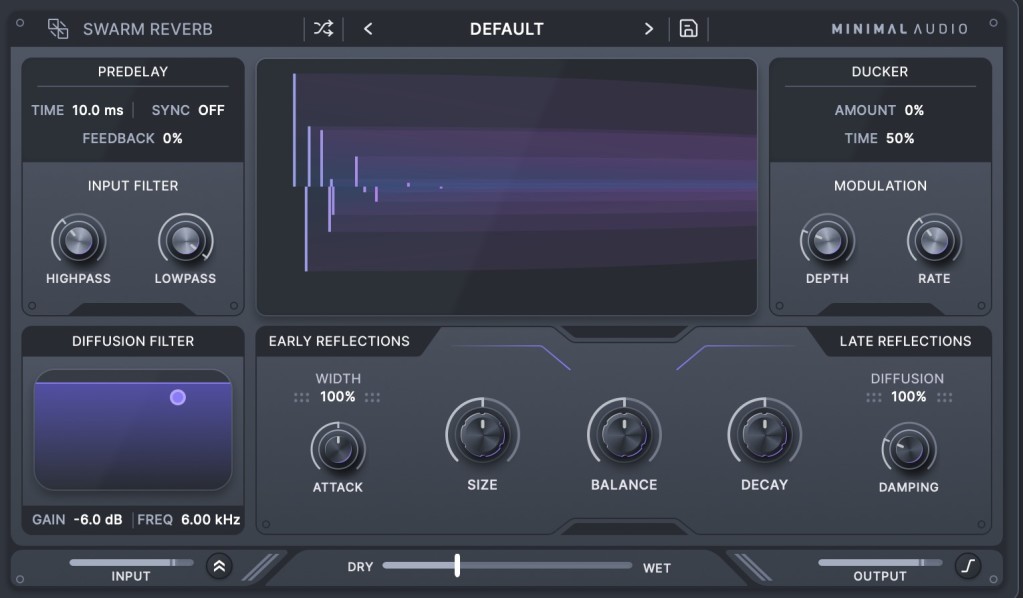
Modulation, keyboards, Stream – and subscriptions
Modulation works how you’d expect from this – you get a set of envelopes and modulators and drag and drop; it’ll feel pretty familiar if you’ve been working with Arturia’s recent plug-ins. The surprise is maybe the cute little keyboard, which is obviously modeled after Teenage Engineering’s OP-1 line. There are some nice arpeggiator and chord options tucked into there. Also, don’t miss the macro knobs on the left.

The other feature – and what presumably may make or break this in the long run as a subscription option – is Stream. That includes presets for every aspect of Current, plus wavetables of various sorts, plus sounds (one-shots, loops, vocal, synth, drums, and SFX). Of course, why this becomes nice is that the sampler and granular engine each load samples, and wavetable loads wavetables. Having that big stock of content means you’re never stuck for material. There’s also cleverly an online/cloud toggle, so you can grab stuff and use it without being connected. This probably isn’t the synth for that studio machine you keep off the internet if that’s your bag, but there’s at least some flexibility. (And if that is your bag, I’m surprised you read this far, but – hi!)
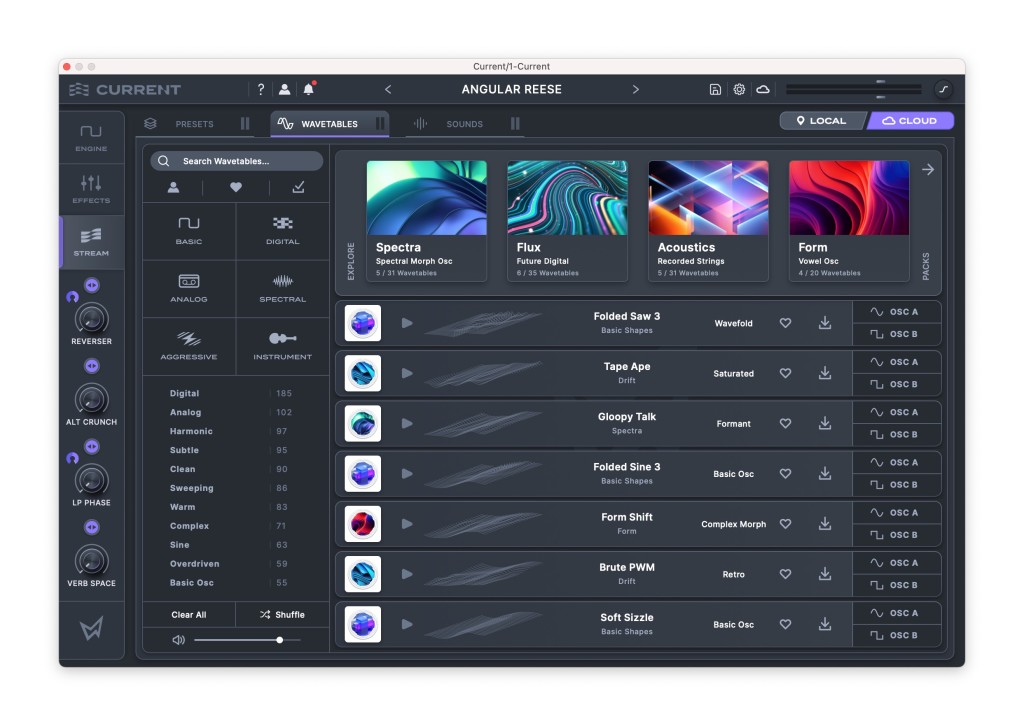
They do answer how this works in the FAQ: samples and wavetables are royalty-free, but you can only use them inside Current. That last bit is a little disappointing. It means you could opt just to get a subscription to something like Loopcloud and use their sounds in any synth you want. But let’s wait and see how the subscription offering evolves.
Minimal is $15 / mo, or $10 a month if you pay yearly – and there’s a full 30-day free trial. You cancel at any time and there’s no commitment.
Interestingly, when you cancel, you can still play back Current. That means that your projects don’t suddenly break if you don’t pay up, which is a big issue with many subscription offerings.
Also, they’re specifically explaining how to make your own preset packs – and it’s nice what they’ve done with the format. I’ve asked more about this works business-wise. But if this takes off, it could be an interesting earning opportunity for producers.
All in all, this is a whole lot of fun to play with. I’m still a little skeptical of having everything baked into one box like this, with samples you can’t use elsewhere, and I still like having Current’s own effects standalone – they say they plan to break off some of these inside Current, even if the synth engine remains subscription-based. But as a sound-making package, it’s pretty inspiring. The granular tools and effects alone are nice. What can I say? We’re spoiled for choice.
There are things they could do to make the subscription easier to handle. There could be a rent-to-own model. There could be the ability to use subscription samples outside the plug-in (which even more confusingly is available as a separate subscription). And even just having an FX version so you also get the effects separately could be a plus. So that does mean you should consider alternatives like Arturia’s Pigments. Updated: They announced a perpetual license replacing the subscription system, with a separate rent-to-own model with content that can be kept after cancellation.
Here’s that video, though I’ll follow up with more once Minimal responds to some questions from me. I was aware during testing that they planned a subscription model and had communicated with them about it.
But pricing model aside , this is absolutely an alien mothership of enormous, futuristic, granulated, effected sounds with bass impact to spare. It’s a luxury trip into synthesis, into making new unimagined sounds.
Let us know what you think of this one or if you’d like to know more: